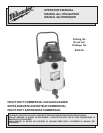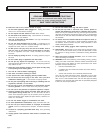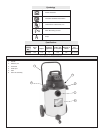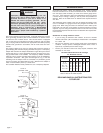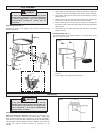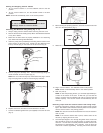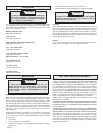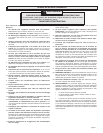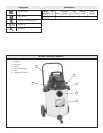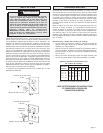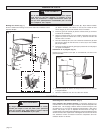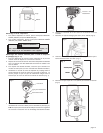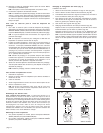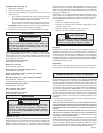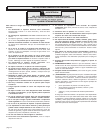
page 2
GENERAL SAFETY RULES
To reduce the risk of fire, electric shock or injury:
1. Do not leave appliance when plugged in. Unplug from outlet
when not in use and before servicing.
2. Do not expose vacuum cleaner to rain. Store indoors.
3. Do not allow to be used as a toy. Close attention is necessary
when used by or near children.
4. Use only as described in this manual. Use only manufacturer’s
recommended attachments.
5. Do not use with damaged cord or plug. If appliance is not
working as it should, has been dropped, damaged, left outdoors, or
dropped into water, return it to a service center.
6. Do Not: pull or carry by cord, use cord as a handle, close a
door on cord, or pull cord around sharp edges or corners.
Do not run appliance over cord. Keep cord away from heated
surfaces.
7. Do not unplug by pulling on cord. To unplug, grasp the plug not
the cord.
8. Do not handle plug or appliance with wet hands.
9. Do not put any object into openings. Do not use with any
openings blocked; keep free of dust, lint, hair, and anything else that
may reduce air flow.
10. Keep hair, loose clothing, fingers, and all parts of body away
from openings and moving parts.
11. Turn off all controls before unplugging.
12. Use extra care when cleaning on stairs.
13. Use special care when emptying heavily loaded tanks.
14. Do not leave the cord lying on the floor once you have
finished the cleaning job. It can become a tripping hazard.
15. Do not pick up anything that is burning or smoking such as
cigarettes, matches, or hot ashes.
16. Do not use to pick up flammable or combustible liquids
such as gasoline or use in areas where they may be present.
17. Do not use in the presence of explosive liquids or vapors.
18. Vacuum cleaners have motors and other parts that can pro-
duce sparks during normal use. Do not use within 30 feet of
areas where explosive gases may be present (such as gasoline
pumps and places where liquids like paint thinners, cleaners, sol-
vents, etc. are stored).
19. Do not use where oxygen or anesthetics are used.
20. To avoid spontaneous combustion, empty tank after each use.
21. Do not use your vacuum cleaner as a sprayer of flammable
liquids such as oil based paints, lacquers, household cleaners,
etc.
22. Connect to a properly grounded outlet only. See grounding
instructions.
23. Unplug power cord whenever motor head is removed from
tank.
WARNING!
READ AND UNDERSTAND ALL INSTRUCTIONS
Failure to follow all instructions listed below, may result in
electric shock, fire and/or serious personal injury.
SAVE THESE INSTRUCTIONS.
24. Do not use without dust bag and filter in place.
25. Do not pick up wood or coal ash, soot, cement, plaster or
drywall dust without full cloth filter or collection bag in place.
These are very fine particles that may pass through the foam and
disc filters and affect the performance of the motor or be exhausted
back into the air. Full cloth filters and additional collection filter bags
are available.
26. To reduce the risk of health hazards from vapors or dust, do
not vacuum toxic, carcinogenic or other hazardous materials such
as asbestos, arsenic, barium, berylium, lead, pesticides or other
health endangering materials.
27. Always wear safety goggles when operating vacuum.
28. STAY ALERT. Watch what you are doing and use common sense.
Do not use vacuum cleaner when you are tired, distracted or under
the influence of drugs, alcohol or medication causing diminished
control.
29. Wear electrically insulated footwear, such as rubber boots,
when vacuuming wet material.
30. WARNING! Some dust created by power sanding, sawing, grinding,
drilling, and other construction activities contains chemicals known
to cause cancer, birth defects or other reproductive harm. Some
examples of these chemicals are:
• lead from lead-based paint
• crystalline silica from bricks and cement and other masonry
products, and
• arsenic and chromium from chemically-treated lumber.
Your risk from these exposures varies, depending on how often
you do this type of work. To reduce your exposure to these chemi-
cals: work in a well ventilated area, and work with approved safety
equipment, such as those dust masks that are specifically designed
to filter out microscopic particles.



